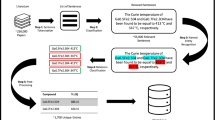Abstract
In this article we present the matchmaking problem in industrial symbiosis where wastes from one company are matched with resources of another company that could be substituted. Identifying potential matches is difficult, as it is based on knowledge that certain wastes can substitute certain resources. Capturing this knowledge in the form of waste-resource matching rules manually is time-consuming. Therefore, we argue that a Natural Language Processing (NLP)-based approach of semi-automatically extracting rules from domain-specific data sets could be a viable approach to solving this problem. The basic NLP problem to solve is to find similar concepts (synonyms), part-whole relationships (meronyms), and “is a” relationships (hyponyms). Synonyms are important for finding wastes and resources that are named differently but refer to the same object. For example, water and its chemical formula H2O are often used interchangeably. Meronyms are part-whole relationships that may help to identify wastes with components that could be used as a resource. For example, methane is a component of natural gas. Hyponyms allow for building taxonomies. For example, wood is a kind of biomass. We present the results of an initial literature survey of algorithms that are able to find these relationships in large sets of unstructured text documents. Furthermore, we propose a research approach for further extending the literature survey and testing the existing algorithms on small test cases and a realistic matchmaking case. For future work, additional problems that fall into the NLP category can be addressed such as semi-automatically identifying processes for converting wastes into resources.
Access this chapter
Tax calculation will be finalised at checkout
Purchases are for personal use only
Similar content being viewed by others
References
Hein, A., Jankovic, M., Farel, R., Yannou, B.: A data- and knowledge-driven methodology for generating eco-industrial park architectures. In: Proceedings of the ASME 2016 International Design Engineering Technical Conferences and Computers and Information in Engineering Conference IDETC/CIE 2016 (2016)
Li, X.: Quality time-what’s so bad about rule-based programming? Softw. IEEE (1991)
Vargas, J., Raj, S.: Developing maintainable expert systems using case‐based reasoning. Expert Syst. (1993)
Sollow, E.: Assessing the maintainability of XCQN-in-RIME: coping with the problems of a VERY large rule-base (1987)
Hirschberg, J., Manning, C.: Advances in natural language processing. Science 80 (2015)
Cambria, E., White, B.: Jumping NLP curves: a review of natural language processing research. IEEE Comput. Intell. Mag. 9(2), 48–57 (2014)
Lehnert, W., Ringle, M.: Strategies for natural language processing (2014)
Cecelja, F., Raafat, T., Trokanas, N., Innes, S., Smith, M., Yang, A., Zorgios, Y., Korkofygas, A., Kokossis, A.: e-Symbiosis: technology-enabled support for industrial symbiosis targeting small and medium enterprises and innovation. J. Clean. Prod. 98, 336–352 (2015)
Maedche, A., Staab, S.: Semi-automatic engineering of ontologies from text. In: Proceedings of the 12th International conference on software engineering and knowledge engineering, 231–239 (2000)
Wächter, T., Schroeder, M.: Semi-automated ontology generation within OBO-edit. Bioinformatics (2010)
Lee, C., Kao, Y., Kuo, Y., Wang, M.: Automated ontology construction for unstructured text documents. Data Knowl. Eng. (2007)
Gawrysiak, P., Protaziuk, G.: Text onto miner–A semi automated ontology building system. Found. In: International Symposium on Methodologies for Intelligent Systems, 563–573,(2008)
Fortuna, B., Grobelnik, M., Mladenic, D.: Semi-automatic data-driven ontology construction system. In: Proceedings of Semantics, Web and Mining, 121–131 (2006)
Harris, Z.: Distributional structure. Word (1954)
Firth, J.: A synopsis of linguistic theory, 1930–1955 (1957)
Van de Cruys, T.: Distributional similarity—overview and applications (2010)
Goldberg, Y., Levy, O.: Word2Vec explained: deriving mikolov et al.’s negative-sampling word-embedding method. arXiv Prepr. arXiv1402.3722 (2014)
Mikolov, T., Sutskever, I., Chen, K.: Distributed representations of words and phrases and their compositionality. Advances in neural information processing systems, 3111–3119 (2013)
Hagiwara, M.: A supervised learning approach to automatic synonym identification based on distributional features. In: Proceedings of the 46th Annual Meeting of the Association for Computational Linguistics on Computational Linguistics, p.225–232, Manchester, United Kingdom, August 18–22 2008
Landauer, T., Foltz, P., Laham, D.: An introduction to latent semantic analysis. Discourse Process, 259–284 (1998)
Papadimitriou, C., Tamaki, H.: Latent semantic indexing: A probabilistic analysis. J Comput. Syst. Sci. 61(2), 217–235 (2000)
Wang, C., Cao, L., Zhou, B.: Medical synonym extraction with concept space models. arXiv Prepr. arXiv1506.00528 (2015)
Ittoo, A., Bouma, G., Maruster, L., Wortmann, H.: Extracting Meronymy relationships from domain-specific, textual corporate databases. In: Natural Language Processing and Information Systems Volume 6177 of the series Lecture Notes in Computer Science, pp. 48–59 (2010)
Berland, M., Charniak, E.: Finding parts in very large corpora. In: Proceedings of the 37th Annual Meeting of the ACL, 57–64 (1999)
Roberts, A.: Learning meronyms from biomedical text. In: Proceedings of the ACL Student Res. Work (2005)
Hearst, M.: Automatic acquisition of hyponyms from large text corpora. In: Proceedings of the 14th International Conference on Computational. Linguistics, Nantes France (1992)
Maedche, A., Staab, S.: Ontology learning. Handb. Ontol. (2004)
Kietz, J., Maedche, A., Volz, R.: A method for semi-automatic ontology acquisition from a corporate intranet. In EKAW-2000 Workshop “Ontologies and Text”, Juan-Les-Pins, (2000)
Author information
Authors and Affiliations
Corresponding author
Editor information
Editors and Affiliations
Rights and permissions
Copyright information
© 2017 Springer Nature Singapore Pte Ltd.
About this paper
Cite this paper
Hein, A.M., Yannou, B., Jankovic, M., Farel, R. (2017). Towards an Automatized Generation of Rule-Based Systems for Architecting Eco-Industrial Parks. In: Chakrabarti, A., Chakrabarti, D. (eds) Research into Design for Communities, Volume 1. ICoRD 2017. Smart Innovation, Systems and Technologies, vol 65. Springer, Singapore. https://doi.org/10.1007/978-981-10-3518-0_60
Download citation
DOI: https://doi.org/10.1007/978-981-10-3518-0_60
Published:
Publisher Name: Springer, Singapore
Print ISBN: 978-981-10-3517-3
Online ISBN: 978-981-10-3518-0
eBook Packages: EngineeringEngineering (R0)




